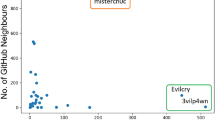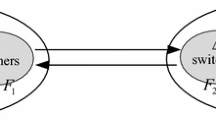Abstract
Many software products and information technology services are mediated by platforms. Often these platforms feature the simultaneous occurrence of both positive and negative network externalities, e.g., the most popular operating systems are the most attractive platforms for both application developers and hackers alike. In this context, consumers experience a negative network externality in the form of an increased probability of cyber attack (which the platform developer can mitigate by promptly issuing patches, a costly activity) and a positive network externality stemming from increased variety of compatible applications. In this paper, we analyze the interplay between market structure and the provision of quality (in the form of security) by platform developers. The analysis of a differential game model of duopolistic competition by platform developers indicates that the long-run market structure is dependent on the degree to which hackers react to market share asymmetries. When the dominant platform attracts almost the entire hacking activity, the industry evolves toward a less-concentrated market structure even though the net network effect is positive. Conversely, when hacking activity is less sensitive to market share asymmetries, the equilibrium long-run market structure is asymmetric. The degree of asymmetry in long-run equilibrium market shares is decreasing with the increasing hacker sensitivity to market dominance.

Similar content being viewed by others
References
Armstrong M (2007) Competition in two-sided markets. Rand J Econ 37(3):668–691
Cabral L (2011) Dynamic price competition with network effects. Rev Econ Stud 78:83–111
Caillaud B, Jullien B (2003) Chicken egg: competition among intermediation service providers. Rand J Econ 34(2):309–328
Dockner E, Jorgensen S, Van Long N, Sorger G (2000) Differential games in economics and management science. Cambridge University Press, Cambridge
Galbreth M, Shor M (2010) The impact of malicious agents on the enterprise software industry. MIS Quart 34(3):595–612
Grivaa K, Vettas N (2011) Price competition in a differentiated products duopoly under network effects. Inf Econ Policy 23(1):85–97
Katz M, Shapiro C (1994) Systems competition and network effects. J Econ Perspect 8(2):93–115
Laussel D, Montmarina M, Van Long N (2004) Dynamic duopoly with congestion effects. Int J Ind Organ 22(5):655–677
Liebowitz S, Margolis S (1999) Winners, losers & microsoft. The Independent Institute, Oakland
Mitchell M, Skrzypacz A (2006) Network externalities and long-run market share. Econ Theory 29:621–648
Rochet J-C, Tirole J (2003) Platform competition in two-sided markets. J Eur Econ Assoc 1(4):990–1029
Shen J (2011) Analyzing the effects of network externalities in dynamic strategic investment. PhD dissertation, University of Virginia
Tellis G, Yin E, Niraj R (2009) Does quality win? Network effects versus quality in high-tech markets. J Mark Res 46(2):135–149
Acknowledgments
This work was partially supported by NSF grant CNS-0627399.
Author information
Authors and Affiliations
Corresponding author
Appendix
Appendix
1.1 Proof of Proposition 1
1.1.1 Preliminaries
The quadratic equation in the statement of Proposition 1 has real roots whenever
If \(\ell <1\), then this is equivalent to
The minimal root is
Thus, \(a\in \left( 0,\frac{1}{\sqrt{2}}\right) \) for \(\ell \in (\bar{\ell },1)\). Note that if \(\ell =1\) then the unique solution is \(a=0\). If \(\ell >1\), then the condition for real roots is
1.1.2 Necessary Conditions
In order to simplify the analysis, we make a change of variable \(x_{i}=n_{i}- \frac{1}{2}\) so that \(x_{i}-x_{j}=n_{i}-n_{j}\) and \(x_{i}+x_{j}=n_{i}-\frac{1 }{2}+n_{j}-\frac{1}{2}=0\). In the new variables, the continuous time dynamics can be rewritten as
The instantaneous profit rate can be rewritten as
Let us define the Hamiltonians as follows:
where \(x_{1}\) is the state variable and \(\lambda _{i}\) denote the co-state variables at time \(t>0\). The Hamiltonians are strictly concave. First order conditions for MPE (see [4]) are
Conditions given by (4) lead to
Conditions given by (5) lead to
The solution is
and
1.1.3 Solving (6)
Note that
Hence,
So
In addition,
and
Hence, condition in (6) leads to
We rewrite the system in (7) and (8) as follows:
We posit a solution of the form:
Then
and
Condition (9) can be rewritten as
Thus, the parameters \(a\) and \(b\) must satisfy
From (12) it follows that \(b=\frac{1}{2(1+r)}\).
1.1.4 Consistency
Finally, we check that the equilibrium strategies are consistent with \(q_{i}(t)\) being a probability. Note that under the equilibrium strategies, we have
Since \(a<\frac{1}{\sqrt{2}}\) it follows that \((1+2a)(1-\ell )<1\) for \(\ell \in (\bar{\ell },1)\). Hence, \(q_{1}(t)\in (0,1)\) for \(t>0\).
1.2 Proof of Lemma 1
We first show that \(\ell -2a(1-\ell )\) is increasing in \(\ell \in (\bar{\ell } ,1)\). Let \(f(\ell )=\ell -2a\left( \ell \right) \times (1-\ell )\). The derivative is
Since \(a\) is the minimal root of the quadratic equation, we have
Assume that \(x=1-\frac{r+2\ell }{1-\ell }=3-\frac{2+r}{1-\ell },\) then
Therefore, that \(\ell -2a(1-\ell )\) is increasing in \(\ell \).
To show (b), note that the average security provided in the market is
The time derivative is
Therefore, the average security level decreases in \(\ell \) until the market reaches at the equilibrium where both firms have the same market share. The average security level at the long-run equilibrium is \(\frac{1}{2}.\)
1.3 Proof of Proposition 2
Let \(x_{1}=n_{1}-\frac{1}{2}\). The condition \(\frac{\partial H_{i}}{ \partial p_{i}}=0\) yields
which we rewrite as
The solution is
Moreover, the conditions
can be rewritten as
since
We posit a solution of the form
This leads to the quadratic equation
and \(b=\frac{1}{2(1+r)}\). By hypothesis, \(\frac{3}{2}\left( \bar{\ell }-\frac{1}{3} \right) <\ell \) thus, \(\ell _{0}=\frac{1}{3}+\frac{2}{3}\ell >\) \(\bar{\ell }\) and the above quadratic equation has real solutions.
Finally, note that
where the last inequality follows for the fact that \(\bar{k} <\frac{\ell +2(1-a(1-\ell _{0}))}{2}\) and \(\ell <\frac{1+2\sqrt{2}-r}{3+2\sqrt{2}}=\bar{ \ell }<1\). Similarly, we can show that \(\frac{\partial H_{2}}{\partial k_{2}} <0\) for \(k_{2}\in [0,\bar{k}]\).
Rights and permissions
About this article
Cite this article
Garcia, A., Sun, Y. & Shen, J. Dynamic Platform Competition with Malicious Users. Dyn Games Appl 4, 290–308 (2014). https://doi.org/10.1007/s13235-013-0102-y
Published:
Issue Date:
DOI: https://doi.org/10.1007/s13235-013-0102-y




